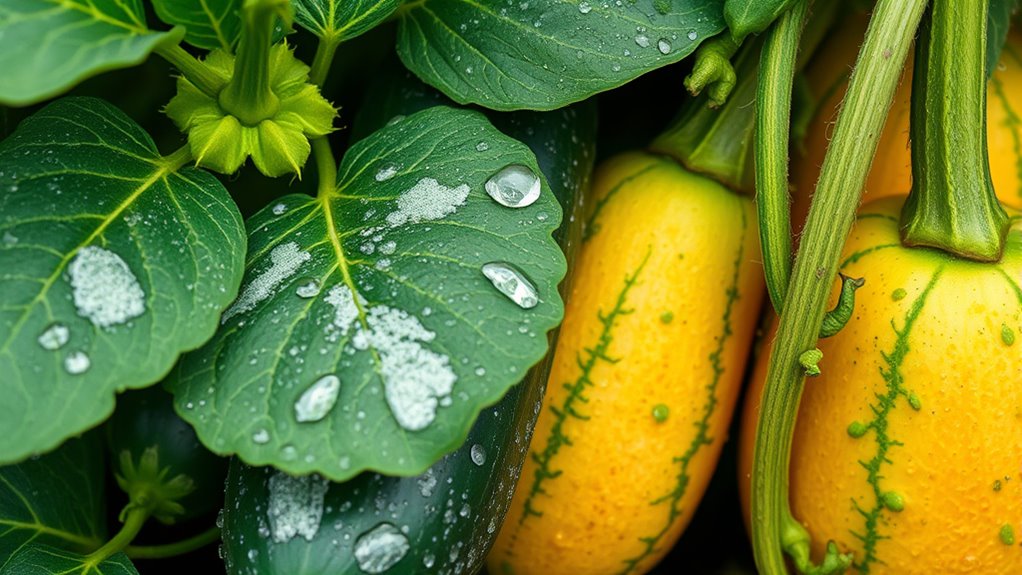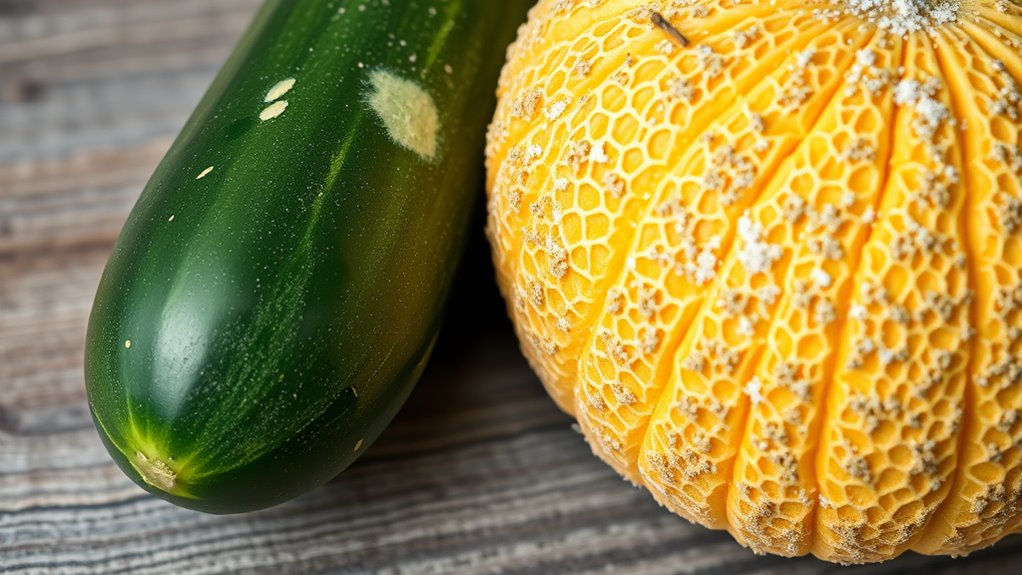You’ll find that cucumbers are more prone to powdery mildew than cantaloupes because their dense foliage creates a microclimate perfect for fungal growth. The thick leaves and plant structure in cucumbers trap moisture and shade, making them more vulnerable. Cantaloupes usually resist better thanks to their less dense leaves and better air circulation. To protect your plants effectively, understanding these differences can guide your prevention efforts—keep exploring for some helpful tips.
Key Takeaways
- Cucumbers are more susceptible to powdery mildew than cantaloupes due to dense foliage and microclimate creation.
- Cantaloupes have less dense leaves, allowing better air circulation and reducing fungal growth risk.
- Cucumber plants require more vigilant prevention measures like regular fungicide use and pruning.
- Both crops can develop powdery mildew, but environmental factors like humidity influence their susceptibility.
- Tailored disease management practices are essential for effective control: cucumbers need proactive measures, cantaloupes benefit from cultural practices.

Have you ever wondered how cucumbers and cantaloupes compare? When it comes to powdery mildew risk, understanding their differences can help you better manage your garden. Powdery mildew is a common fungal disease that can quickly spread across plants, causing leaf distortion, reduced photosynthesis, and lower yields. Knowing which crop is more susceptible allows you to implement targeted disease prevention strategies effectively.
Cucumbers generally face a higher crop susceptibility to powdery mildew than cantaloupes. This increased vulnerability stems from their leaf structure and growing conditions. Cucumber plants tend to develop dense foliage, creating a microclimate perfect for fungal spores to thrive. Their leaves are often more susceptible to early infection, especially if you grow them in shaded or humid environments. Because of this, cucumbers often require more vigilant disease prevention measures, such as regular fungicide applications, pruning to improve air circulation, and ensuring proper spacing during planting. If you neglect these precautions, powdery mildew can spread rapidly, reducing plant vigor and fruit production.
In contrast, cantaloupes are somewhat more resistant to powdery mildew, partly due to their growth habits and leaf characteristics. Their leaves are typically less dense, and their overall plant architecture promotes better air flow, which naturally helps inhibit fungal development. Still, cantaloupes aren’t immune. They can develop powdery mildew under prolonged periods of high humidity or poor air circulation. To minimize risk, it’s vital to practice good cultural controls, such as crop rotation, removing infected plant debris, and avoiding overhead watering that keeps moisture on the leaf surface. These practices bolster disease prevention and help maintain healthy cantaloupe crops.
While disease prevention is essential for both crops, understanding their differing susceptibilities guides your approach. For cucumbers, proactive measures are indispensable because their higher crop susceptibility makes them prime targets for powdery mildew. Regular monitoring, early intervention, and environmental management are key to keeping the disease at bay. For cantaloupes, maintaining good growing conditions and practicing preventative cultural tactics usually suffices, but vigilance remains necessary.
Ultimately, knowing how cucumbers and cantaloupes compare in terms of powdery mildew risk helps you make smarter decisions in your gardening practices. Tailoring your disease prevention efforts based on each crop’s susceptibility will markedly improve your chances of a healthy, productive harvest. By staying attentive to their specific needs and vulnerabilities, you can reduce the impact of powdery mildew and enjoy thriving plants throughout the season.
Frequently Asked Questions
How Does Humidity Affect Powdery Mildew Development?
High humidity levels promote powdery mildew development, so you need to focus on humidity control. When humidity stays elevated, the disease progresses faster because the spores thrive in moist environments. To reduce risk, ensure good air circulation and avoid overhead watering. By managing humidity, you slow down disease progression, keeping your plants healthier and less vulnerable to powdery mildew. Proper humidity control is essential for disease prevention and control.
Are There Resistant Cucumber or Cantaloupe Varieties?
Think of resistant cultivars as your armor against powdery mildew. Yes, there are cucumber and cantaloupe varieties with genetic resistance, making your plants less vulnerable. These resistant cultivars are bred specifically to withstand fungal attacks, helping you reduce the need for chemical treatments. By choosing these resilient options, you give your crops a fighting chance, ensuring healthier plants and a more bountiful harvest without the worry of powdery mildew taking over.
What Organic Treatments Effectively Prevent Powdery Mildew?
You can effectively prevent powdery mildew using organic treatments like organic fungicides and natural remedies. Apply neem oil or potassium bicarbonate solutions regularly to keep the fungus at bay. Using compost teas or diluted milk sprays also helps strengthen plant defenses. Make sure to improve air circulation and avoid overhead watering, as these practices complement organic treatments and markedly reduce powdery mildew risks on your cucumbers or cantaloupe.
Can Crop Rotation Reduce Powdery Mildew Risk?
Crop rotation can substantially reduce powdery mildew risk by breaking the disease cycle, which affects over 40% of vegetable crops annually. You should focus on improving soil health and increasing crop diversity, as rotating plants prevents pathogen buildup. Switching crops each season disrupts fungal life cycles, making it harder for powdery mildew to thrive. So, rotating crops is an effective way to protect your garden naturally.
How Does Powdery Mildew Impact Crop Yield Quality?
Powdery mildew can markedly reduce your crop’s yield quality by promoting fungus proliferation on leaves and fruit surfaces. This disease causes fruit deterioration, leading to blemishes, soft spots, and decreased marketability. As a result, your harvest may be smaller and less appealing, impacting your income. To protect your crops, make certain proper spacing, improve air circulation, and apply appropriate fungicides to minimize mildew development and maintain high-quality produce.
Conclusion
As you navigate the lush world of cucumbers and cantaloupes, remember that their battle with powdery mildew is like a delicate dance on a thin wire. Cucumbers, with their vigor, may outlast the white menace, but cantaloupes, sweet and tender, invite more cautious steps. Stay vigilant, nurture your plants like a caring gardener tending to fragile dreams, and you’ll keep this fungal foe at bay, ensuring your garden blossoms with health and flavor.









